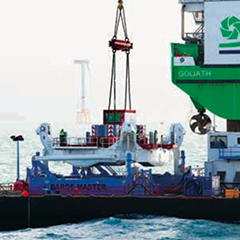The renewable energy industry as a whole is obsessed with lowering costs throughout the supply chain – and efforts are keener than ever in the offshore wind sector. Barge Master is leading the way in this regard, with an innovative selection of systems that reduce the wasted time spent waiting for improved weather conditions. We put our questions to the company’s founder Martijn Koppert.
The smaller BM-T40 with integrated crane can be used for various smaller lifts, like grouting hoses or supplying spare parts for maintenance of offshore wind farms, all year long.
PES: How long has offshore wind been part of your portfolio? Is the sector reaping rewards for you?
MK: We’ve designed our first product (the BM-T700) to mainly focus on the offshore wind industry. This is because most wind
PES: Welcome to PES. Would you like to tell us a little about the company and how you service the wind industry?
Martijn Koppert: Barge Master develops motion-compensation systems, creating platforms that don’t move in relation to the stationary world. The systems increase the safety and workability of offshore operations, which results in a cost reduction for our clients. Furthermore, Barge Master systems are deployed worldwide in service of energy majors, offshore contractors, maritime service providers, dredging companies, shipyards and salvage companies.
The Barge Master T700 is a portable and flexible platform that can carry a 400- 600mT crane, or, alternatively, compensate loads of up to 700mT when used as a supply platform. The Barge Master T40 features a small footprint and is designed to compensate for sea induced motions of a knuckle boom crane with a lifting capacity of 15mT at a 10 meter radius or 5mT at a 20 meter radius. The servicing of wind turbines or unmanned oil rigs are typical applications of the Barge Master T40. The system is based on the same principle as the Barge Master T700: roll, pitch and heave are compensated, while surge, sway and yaw are fixated.
Both the BM-T700 and the BM-T40 are capable of servicing the wind industry in different ways:
The BM-T700 can be used for supplying parts (turbines, monopiles, transition pieces etc.) independent of ocean conditions. Especially when combining two systems, resulting in a payload capacity of 1400 mT. farms are located in the North Sea, where ocean conditions are harsh most of the year. Without using a motion compensation system there is a lot of downtime due to waiting for better weather conditions – and this is one of the reasons why offshore construction costs are that high. So this presents us with big chance for improvement; specifically to reduce the price of offshore wind.























